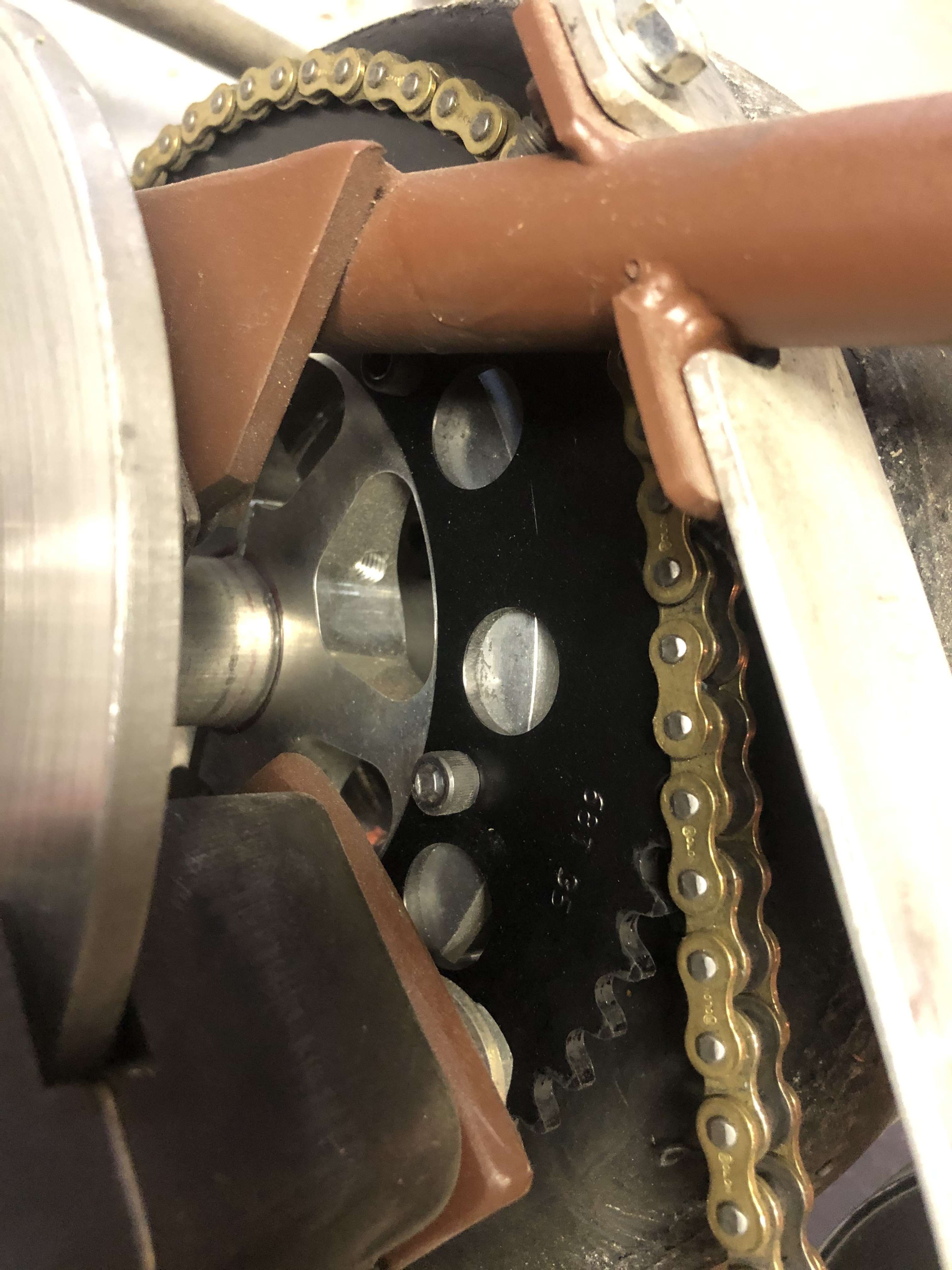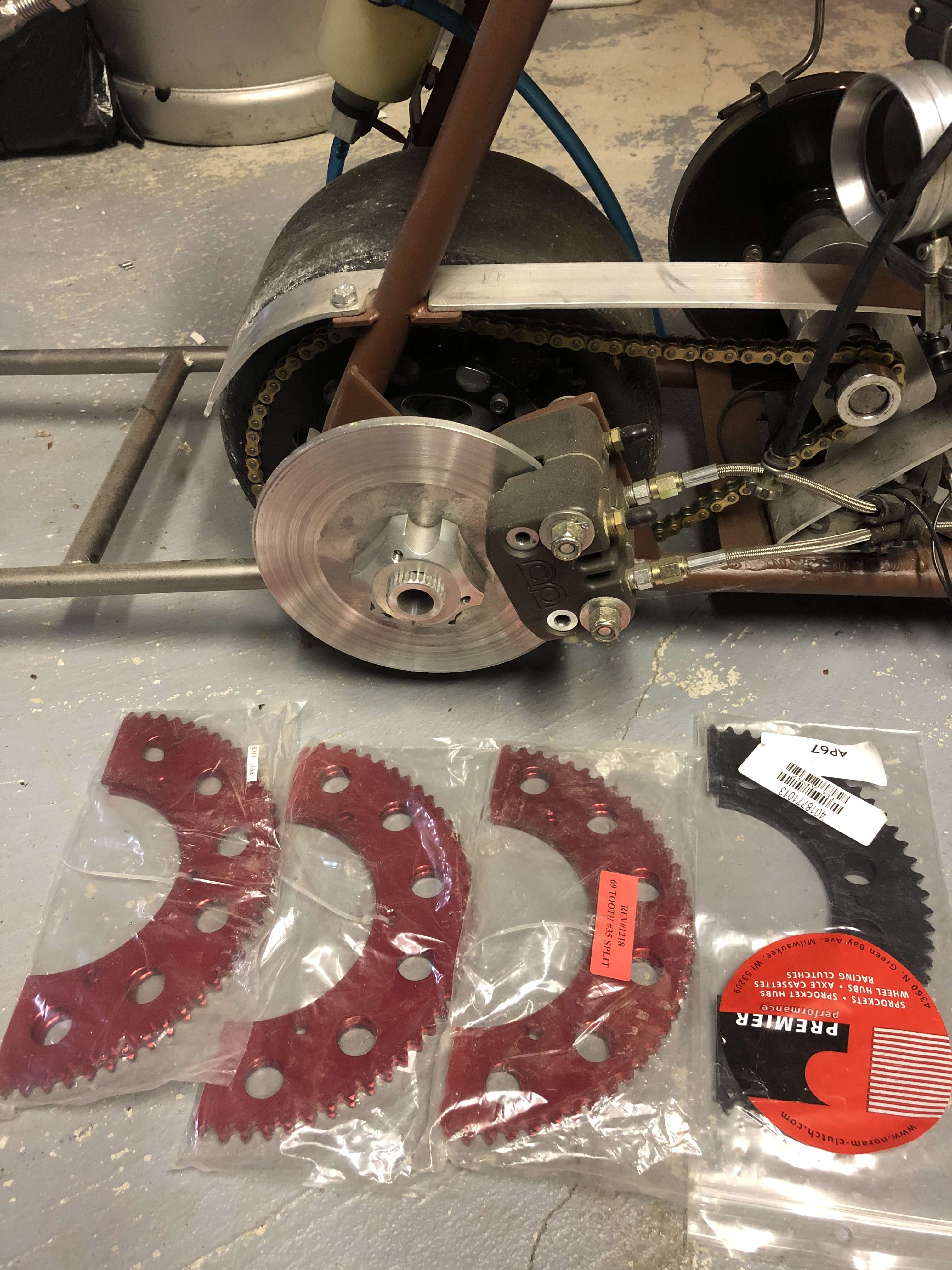Doodlebug sprocket
- Thread starter myden
- Start date
Hi there,
I'm curious what kind of sprocket setups are being used. We're trying to use a split sprocket with 62 teeth and a 35 chain. We're having trouble getting it to work very smoothly. Any input would be appreciated.
I'm curious what kind of sprocket setups are being used. We're trying to use a split sprocket with 62 teeth and a 35 chain. We're having trouble getting it to work very smoothly. Any input would be appreciated.

The sprocket usually goes next to the wheel, like you have it, because that's where the original sprocket would have been. It can be reversed, like in Tony's photo, moving the sprocket farther out, to accommodate a wider tire and/or wider engine (if the frame allows).
https://www.bmikarts.com/Baja-Doodlebug-Sprocket-Adapter-Plate_p_7093.html
Check your sprocket alignment using a straightedge.


No offense but that's a cheap sprocket, but it's what most places sell. By cheap, I mean that it's a stamped sprocket. A stamped sprocket typically will have slightly rounded edges on one side and rather sharp edges on the other. High quality sprockets are hobbed (machined) and have chamfered teeth for smoother engagement. I was fortunate to find a few NOS #35 AFAM split sprockets a couple of years ago at great prices. AFAM (former name, recently changed to Drive Systems) has made some of the best motorcycle sprockets and chain for years but no longer make the #35 sprockets.

If your sprocket alignment is good, you could try chamfering the sprocket teeth. To do that, I would use a sanding disc, held lightly against the teeth while the sprocket is spinning. WARNING: This could be slightly dangerous if you're not accustomed to doing such things. Another option would be to have a machine shop chamfer the teeth but that would probably cost more than buying a high quality sprocket.
https://www.bmikarts.com/Baja-Doodlebug-Sprocket-Adapter-Plate_p_7093.html
Check your sprocket alignment using a straightedge.


No offense but that's a cheap sprocket, but it's what most places sell. By cheap, I mean that it's a stamped sprocket. A stamped sprocket typically will have slightly rounded edges on one side and rather sharp edges on the other. High quality sprockets are hobbed (machined) and have chamfered teeth for smoother engagement. I was fortunate to find a few NOS #35 AFAM split sprockets a couple of years ago at great prices. AFAM (former name, recently changed to Drive Systems) has made some of the best motorcycle sprockets and chain for years but no longer make the #35 sprockets.

If your sprocket alignment is good, you could try chamfering the sprocket teeth. To do that, I would use a sanding disc, held lightly against the teeth while the sprocket is spinning. WARNING: This could be slightly dangerous if you're not accustomed to doing such things. Another option would be to have a machine shop chamfer the teeth but that would probably cost more than buying a high quality sprocket.
I've got the adapters on two of mine and run the sprocket inboard to make things line up. Haven't had any issues doing it that way.
Edit: Make sure you have the sprockets lined up correctly. They only go together one way. There should be two dashes on them that indicate how they should be. If you have one flipped you'll have issues.


Edit: Make sure you have the sprockets lined up correctly. They only go together one way. There should be two dashes on them that indicate how they should be. If you have one flipped you'll have issues.


Last edited:
I've got the adapters on two of mine and run the sprocket inboard to make things line up. Haven't had any issues doing it that way.
Edit: Make sure you have the sprockets lined up correctly. They only go together one way. There should be two dashes on them that indicate how they should be. If you have one flipped you'll have issues.
Edit: Make sure you have the sprockets lined up correctly. They only go together one way. There should be two dashes on them that indicate how they should be. If you have one flipped you'll have issues.
I think Charles hit the nail on the head. His sprocket halves are cheap and don't have the beveled teeth. I remember back when I was a kid, my dad and I built an Azusa kit. The sprocket that came with it was the same way, no bevel. It would throw chains constantly, no matter what we did. Years later I finally replaced the sprocket and the replacement was higher quality with beveled teeth. Never threw a chain again.
Yea, I'll be the first to admit I was wrong. Looks like the sprocket can be run inboard and outboard depending on application. I'm just so used to seeing them run outboard.
I think Charles hit the nail on the head. His sprocket halves are cheap and don't have the beveled teeth. I remember back when I was a kid, my dad and I built an Azusa kit. The sprocket that came with it was the same way, no bevel. It would throw chains constantly, no matter what we did. Years later I finally replaced the sprocket and the replacement was higher quality with beveled teeth. Never threw a chain again.
I think Charles hit the nail on the head. His sprocket halves are cheap and don't have the beveled teeth. I remember back when I was a kid, my dad and I built an Azusa kit. The sprocket that came with it was the same way, no bevel. It would throw chains constantly, no matter what we did. Years later I finally replaced the sprocket and the replacement was higher quality with beveled teeth. Never threw a chain again.
FYI: Because chains have an even number of links, odd number tooth count sprockets will provide more uniform sprocket and chain wear than an even number tooth count, extending their life. The inner plates of the chain will rub against half of the teeth of an even number sprocket, but will rub against every tooth of an odd number sprocket. There's more to it than that, it's complicated. It's related to "hunting tooth frequency" for gearsets.
https://www.logisticshandling.com/articles/2012/09/05/1952-why-having-odd-teeth-could-save-you/
https://www.logisticshandling.com/articles/2012/09/05/1952-why-having-odd-teeth-could-save-you/
FYI: Because chains have an even number of links, odd number tooth count sprockets will provide more uniform sprocket and chain wear than an even number tooth count, extending their life. The inner plates of the chain will rub against half of the teeth of an even number sprocket, but will rub against every tooth of an odd number sprocket. There's more to it than that, it's complicated. It's related to "hunting tooth frequency" for gearsets.
https://www.logisticshandling.com/articles/2012/09/05/1952-why-having-odd-teeth-could-save-you/
https://www.logisticshandling.com/articles/2012/09/05/1952-why-having-odd-teeth-could-save-you/
Love split sprockets
Having a live axle means that if you need to shift stuff over a little bit, it’s pretty easy. No messing with spacers etc.
My sprocket hub is just basic jr dragster stuff, not the same as yours but mine is mounted outboard.
If you are going drag racing, having split sprockets are a godsend for tuning the gear ratio, saves so much time.



Having a live axle means that if you need to shift stuff over a little bit, it’s pretty easy. No messing with spacers etc.
My sprocket hub is just basic jr dragster stuff, not the same as yours but mine is mounted outboard.
If you are going drag racing, having split sprockets are a godsend for tuning the gear ratio, saves so much time.



Love split sprockets
Having a live axle means that if you need to shift stuff over a little bit, it’s pretty easy. No messing with spacers etc.
My sprocket hub is just basic jr dragster stuff, not the same as yours but mine is mounted outboard.
If you are going drag racing, having split sprockets are a godsend for tuning the gear ratio, saves so much time.
Having a live axle means that if you need to shift stuff over a little bit, it’s pretty easy. No messing with spacers etc.
My sprocket hub is just basic jr dragster stuff, not the same as yours but mine is mounted outboard.
If you are going drag racing, having split sprockets are a godsend for tuning the gear ratio, saves so much time.
Would love to see some pics of the whole bike.
FYI: Because chains have an even number of links, odd number tooth count sprockets will provide more uniform sprocket and chain wear than an even number tooth count, extending their life. The inner plates of the chain will rub against half of the teeth of an even number sprocket, but will rub against every tooth of an odd number sprocket. There's more to it than that, it's complicated. It's related to "hunting tooth frequency" for gearsets.
https://www.logisticshandling.com/articles/2012/09/05/1952-why-having-odd-teeth-could-save-you/
https://www.logisticshandling.com/articles/2012/09/05/1952-why-having-odd-teeth-could-save-you/
Sorry Charles S. I should of done some research before posting my question. Lots of info online about tooth hunting frequency. Even formulas to help choose your tooth count. I get it now. Thanks again for pointing out this problem.
https://www.kiwibiker.co.nz/forums/archive/index.php/t-103430.html
https://www.kiwibiker.co.nz/forums/archive/index.php/t-103430.html
I had a thread here on the build, and also pics of the bike in my media but i think it got lost when the site switched over.
The thread was pretty long and i just haven’t got around to reposting everything.
Thanks for the kind words



